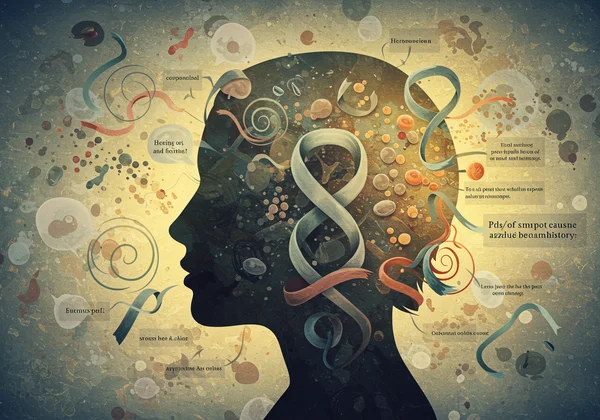PPD & Perinatal Depression: Guide to Symptoms, Causes, EPDS
Navigating the emotional landscape of pregnancy and new parenthood is a journey filled with incredible highs and unexpected lows. While the "baby blues" are a common and temporary experience, persistent feelings of sadness, anxiety, or despair might signal something more serious, like Perinatal or Postpartum Depression (PPD). Understanding the difference is the first step toward feeling better. This guide will demystify PPD, explore its signs and causes, and show you how to find support. So, what is EPDS and how can it help you on your path to healing?
The Edinburgh Postnatal Depression Scale (EPDS) is a simple yet powerful tool designed to help you check in with your emotional well-being. It provides a confidential way to screen for symptoms of depression and anxiety during pregnancy and after childbirth. By taking a few moments for a free EPDS screening, you can gain valuable insight and take a proactive step in managing your mental health.

Understanding Perinatal & Postpartum Depression: What is PPD?
Perinatal depression is a mood disorder that can affect women during pregnancy and up to a year after childbirth. The term "perinatal" covers the entire period, while "postpartum" specifically refers to the time after birth. It's more than just feeling sad; it's a persistent and often overwhelming condition that can interfere with your daily life and your ability to care for yourself and your new baby. Recognizing that this is a medical condition, not a personal failing, is crucial for healing.
"Baby Blues" vs. PPD: Key Differences Explained
Many new mothers experience the "baby blues" within the first two weeks after delivery. This can include mood swings, crying spells, anxiety, and difficulty sleeping. These symptoms are typically mild and resolve on their own without medical intervention. PPD, however, is more intense and lasts longer. The feelings of sadness, guilt, and worthlessness don't fade away and can even worsen over time, requiring support and treatment.
The Broader Spectrum: Perinatal Mood and Anxiety Disorders (PMADs)
It's important to know that PPD is part of a wider group of illnesses called Perinatal Mood and Anxiety Disorders (PMADs). These can include perinatal anxiety, obsessive-compulsive disorder (OCD), and post-traumatic stress disorder (PTSD) related to childbirth. Symptoms can overlap, and sometimes a mother may experience more than one condition. Understanding this broader spectrum helps in seeking the right kind of support.
Recognizing the Signs: Postpartum Depression Symptoms
The symptoms of PPD can vary widely from person to person, but they often disrupt your ability to function. Paying attention to these signs is the first step toward getting help. If you're worried about yourself or a loved one, consider these common indicators.

Emotional & Psychological Symptoms of PPD
- Persistent sadness, hopelessness, or feelings of emptiness.
- Severe mood swings, irritability, or anger.
- Feeling overwhelmed and unable to cope.
- Excessive worry or anxiety, sometimes including panic attacks.
- Difficulty bonding with the baby or feeling disconnected.
- Feelings of worthlessness, shame, or guilt.
- Thoughts of harming yourself or the baby.
Physical & Behavioral Changes to Watch For
- Loss of interest or pleasure in activities you once enjoyed.
- Withdrawing from family and friends.
- Significant changes in appetite—either eating much more or less than usual.
- Inability to sleep (insomnia) or sleeping too much.
- Overwhelming fatigue or loss of energy.
- Unexplained aches, pains, or headaches.
When to Seek Help: Red Flags You Shouldn't Ignore
While any of the above symptoms warrant a conversation with a healthcare provider, some red flags require immediate attention. If you are having thoughts of self-harm or harming your child, it is a medical emergency. Please contact a crisis hotline or emergency services right away. Remember, seeking help is a sign of strength, not weakness. Taking an initial step like using our confidential EPDS test can help clarify your feelings and guide your next steps.
Delving Deeper: Causes and Risk Factors of PPD
There is no single cause of PPD. Instead, it is typically a result of a combination of physical, emotional, and lifestyle factors. Understanding these contributors can help demystify the condition and reduce any feelings of self-blame.

Hormonal Shifts & Biological Predispositions in PPD
After childbirth, the dramatic drop in hormones like estrogen and progesterone can trigger mood changes. For some women, this chemical shift is severe enough to contribute to depression. Other biological factors, such as sleep deprivation and underlying thyroid imbalances, can also play a significant role in your overall mental state.
Life Stressors & Environmental Influences on Perinatal Mental Health
The transition to parenthood is a major life stressor. A lack of social support, relationship difficulties, financial pressures, or a challenging infant (such as a baby with health problems) can all increase the risk of developing PPD. The immense pressure to be a "perfect" parent can add to this emotional burden.
The Role of Previous Mental Health History
A personal or family history of depression, anxiety, or bipolar disorder is one of the strongest predictors of PPD. If you have experienced a mood disorder in the past, it's essential to be proactive about your mental health during the perinatal period and communicate openly with your healthcare provider.
Taking Action: Screening & Diagnosis for Perinatal Depression
You don't have to wait until you're at a breaking point to take action. Early screening and diagnosis are key to a faster recovery and can significantly improve the well-being of both you and your baby.
The Importance of Early Screening: Why It Matters
Early screening helps identify symptoms before they become severe. It opens the door for conversation and allows you to access support sooner. A simple screening can be the catalyst for getting the help you need to feel like yourself again. It’s a small step that can make a world of difference. An online epds test is a great, private way to start this process.
How the EPDS Works: A Trusted Tool for Risk Assessment
The Edinburgh Postnatal Depression Scale (EPDS) is a set of 10 questions designed to assess your risk for perinatal depression. It's not a diagnostic tool, but it is a highly effective way to measure the severity of your symptoms and determine if you should seek a professional evaluation. It's used by healthcare professionals worldwide because of its reliability.
What to Expect from a Clinical PPD Diagnosis
If your screening results indicate a potential risk, the next step is to speak with a doctor or mental health professional. They will conduct a thorough evaluation, which may include a detailed discussion of your symptoms, health history, and life circumstances. A formal diagnosis is the gateway to creating an effective treatment plan tailored to your specific needs.
Pathways to Healing: PPD Treatment Options & Support
Recovery from PPD is absolutely possible, and there are many paths to feeling better. A combination of professional help, strong social support, and dedicated self-care often proves most effective.

Professional Help: Therapy, Counseling, & Medication
Therapy, particularly cognitive-behavioral therapy (CBT) and interpersonal therapy (IPT), can be incredibly effective for PPD. It provides you with coping strategies and a safe space to process your feelings. In some cases, antidepressant medication may be recommended and can be safely used, even while breastfeeding.
Building Your Support System: Friends, Family, & Community Groups
Don't be afraid to lean on your support system. Talk to your partner, trusted friends, and family about how you're feeling. Joining a support group for new mothers, either online or in person, can also be a powerful source of comfort and validation. Knowing you're not alone makes a huge difference.
Simple Self-Care Strategies for New Parents
While it can feel impossible with a newborn, prioritizing small acts of self-care is vital. Try to get as much rest as you can, nourish your body with healthy food, and incorporate gentle movement like a short walk into your day. Even five minutes of quiet time can help reset your mind. These small steps are a form of medicine for your well-being.
Your Mental Health Journey: Empowering Next Steps
The journey of parenthood is transformative, and your mental well-being is paramount. Recognizing the signs of PPD, understanding risk factors, and knowing where to find support are empowering first steps. Remember, you're not alone, and help is always within reach.
Taking an initial, confidential screening is a brave and proactive way to check in with yourself. We invite you to start your screening on our platform. It’s free, takes only a few minutes, and provides immediate results to help you understand your emotional state and decide on your next steps. Take control of your mental wellness journey today.
Frequently Asked Questions About PPD & EPDS Screening
What is EPDS and how does it help with PPD?
The EPDS, or Edinburgh Postnatal Depression Scale, is a 10-question screening tool used to identify mothers who may be at risk for perinatal depression. It helps by providing a quick, objective score of your symptoms, which can be a valuable starting point for a conversation with a healthcare provider about your mental health.
When should EPDS screening be done during pregnancy or postpartum?
Screening can be beneficial at any point during pregnancy and throughout the first year postpartum. Many healthcare providers recommend screening at the first prenatal visit, later in the third trimester, and again at the 6-8 week postpartum checkup. However, you can take a free screening anytime you feel concerned about your emotional well-being.
How is the EPDS score interpreted, and what is a normal EPDS score?
The EPDS is scored on a scale of 0 to 30. While interpretations can vary slightly, a score of 0-9 is generally considered in the normal range, 10-12 suggests the possibility of mild depression, and a score of 13 or higher indicates a likely case of clinical depression. It's vital to remember that a score is not a diagnosis; it's an indicator that a professional consultation is recommended.
What should I do after receiving a high EPDS score?
A high score is a signal to take action. The most important step is to share your results with a healthcare professional, such as your OB/GYN, primary care doctor, or a mental health therapist. They can provide a formal diagnosis and work with you to create a treatment plan. Do not hesitate to reach out for support.
Is the EPDS test free and how long does it take on our platform?
Yes, the EPDS screening on Epds.me is completely free, confidential, and requires no registration. The entire questionnaire typically takes between 3 to 5 minutes to complete, and you will receive your score immediately upon finishing.